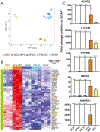Derivation and characterization of putative craniofacial mesenchymal progenitor cells from human induced pluripotent stem cells
- PMID: 30340089
- PMCID: PMC6294687
- DOI: 10.1016/j.scr.2018.10.015
Derivation and characterization of putative craniofacial mesenchymal progenitor cells from human induced pluripotent stem cells
Abstract
The introduction and widespread adoption of induced pluripotent stem cell (iPSC) technology has opened new avenues for craniofacial regenerative medicine. Neural crest cells (NCCs) are the precursor population to many craniofacial structures, including dental and periodontal structures, and iPSC-derived NCCs may, in the near future, offer an unlimited supply of patient-specific cells for craniofacial repair interventions. Here, we used an established protocol involving simultaneous Wnt signaling activation and TGF-β signaling inhibition to differentiate three human iPSC lines to cranial NCCs. We then derived a mesenchymal progenitor cell (NCC-MPCs) population with chondrogenic and osteogenic potential from cranial NCCs and investigated their similarity to widely studied human postnatal dental or periodontal stem/progenitor cells. NCC-MPCs were quite distinct from both their precursor cells (NCCs) and bone-marrow mesenchymal stromal cells, a stromal population of mesodermal origin. Despite their similarity with dental stem/progenitor cells, NCC-MPCs were clearly differentiated by a core set of 43 genes, including ACKR3 (CXCR7), whose expression (both at transcript and protein level) appear to be specific to NCC-MPCs. Altogether, our data demonstrate the feasibility of craniofacial mesenchymal progenitor derivation from human iPSCs through a neural crest-intermediate and set the foundation for future studies regarding their full differentiation repertoire and their in vivo existence.
Copyright © 2018 The Authors. Published by Elsevier B.V. All rights reserved.
Conflict of interest statement
Conflicts of interest
The authors declare that they do not have any conflicts of interest.
Figures





Similar articles
-
iPSC-neural crest derived cells embedded in 3D printable bio-ink promote cranial bone defect repair.Sci Rep. 2022 Nov 4;12(1):18701. doi: 10.1038/s41598-022-22502-8. Sci Rep. 2022. PMID: 36333414 Free PMC article.
-
Induced Pluripotent Stem Cell-Derived Mesenchymal Stromal Cells Are Functionally and Genetically Different From Bone Marrow-Derived Mesenchymal Stromal Cells.Stem Cells. 2019 Jun;37(6):754-765. doi: 10.1002/stem.2993. Epub 2019 Mar 6. Stem Cells. 2019. PMID: 30779868 Free PMC article.
-
Human induced pluripotent stem cell-derived mesenchymal stem cell seeding on calcium phosphate scaffold for bone regeneration.Tissue Eng Part A. 2014 Apr;20(7-8):1295-305. doi: 10.1089/ten.TEA.2013.0211. Epub 2014 Jan 7. Tissue Eng Part A. 2014. PMID: 24279868 Free PMC article.
-
Human Pluripotent Stem Cell-Derived Neural Crest Cells for Tissue Regeneration and Disease Modeling.Front Mol Neurosci. 2019 Feb 22;12:39. doi: 10.3389/fnmol.2019.00039. eCollection 2019. Front Mol Neurosci. 2019. PMID: 30853889 Free PMC article. Review.
-
Dental applications of induced pluripotent stem cells and their derivatives.Jpn Dent Sci Rev. 2022 Nov;58:162-171. doi: 10.1016/j.jdsr.2022.03.002. Epub 2022 Apr 30. Jpn Dent Sci Rev. 2022. PMID: 35516907 Free PMC article. Review.
Cited by
-
Parthenolide promotes expansion of Nestin+ progenitor cells via Shh modulation and contributes to post-injury cerebellar replenishment.Front Pharmacol. 2022 Oct 28;13:1051103. doi: 10.3389/fphar.2022.1051103. eCollection 2022. Front Pharmacol. 2022. PMID: 36386224 Free PMC article.
-
The Potential of Different Origin Stem Cells in Modulating Oral Bone Regeneration Processes.Cells. 2019 Jan 8;8(1):29. doi: 10.3390/cells8010029. Cells. 2019. PMID: 30625993 Free PMC article. Review.
-
The Manufacture of GMP-Grade Bone Marrow Stromal Cells with Validated In Vivo Bone-Forming Potential in an Orthopedic Clinical Center in Brazil.Stem Cells Int. 2019 Nov 7;2019:2608482. doi: 10.1155/2019/2608482. eCollection 2019. Stem Cells Int. 2019. PMID: 31781235 Free PMC article.
-
Public RNA-seq data-based identification and functional analyses reveal that MXRA5 retains proliferative and migratory abilities of dental pulp stem cells.Sci Rep. 2023 Sep 20;13(1):15574. doi: 10.1038/s41598-023-42684-z. Sci Rep. 2023. PMID: 37730838 Free PMC article.
-
The Progress of Stem Cell Technology for Skeletal Regeneration.Int J Mol Sci. 2021 Jan 30;22(3):1404. doi: 10.3390/ijms22031404. Int J Mol Sci. 2021. PMID: 33573345 Free PMC article. Review.
References
-
- Ahlgren SC, Bronner-Fraser M, 1999. Inhibition of Sonic hedgehog signaling in vivo results in craniofacial neural crest cell death. Curr. Biol 9, 1304–1314. - PubMed
-
- Benjamini Y, Hochberg Y, 1995. Controlling the false discovery rate - a practical and powerful approach to multiple testing. J. R. Stat. Soc. Ser. B-Methodol 57, 289–300.
-
- Beverdam A, Brouwer A, Reijnen M, Korving J, Meijlink F, 2001. Severe nasal clefting and abnormal embryonic apoptosis in Alx3/Alx4 double mutant mice. Development 128, 3975–3986. - PubMed
-
- Brainarray, 2017. Description of Customized CDF Files Retrieved October 20 2017, from. http://brainarray.mbni.med.umich.edu/Brainarray/Database/CustomCDF.
-
- Brettschneider J, Collin F, Bolstad BM, Speed TP, 2008. Quality assessment for short oligonucleotide microarray data. Technometrics 50, 241–264.
Publication types
MeSH terms
Grants and funding
LinkOut - more resources
Full Text Sources
Medical
Molecular Biology Databases

